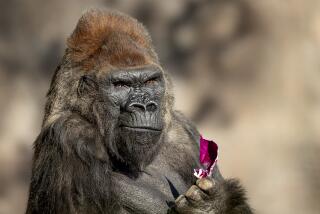King Tut, Zoo’s Famous Longtime Greeter, Dies
King Tut, the salmon-crested cockatoo that served for 64 years as the San Diego Zoo’s official greeter and became one of its best-known symbols, died Sunday. The oldest bird at the zoo, he was believed to be at least 67.
Tut, who greeted well over 100 million visitors from his perch near the zoo’s entrance from 1925 until his retirement in 1989, was found floundering Sunday morning in the zoo’s bird yard by keepers, who had heard odd squawking noises.
Veterinarians brought oxygen and tried cardiopulmonary resuscitation on Tut, who had fallen from his perch. But the bird, a veteran of stage and screen whose frailty in recent years had prompted his retirement and whose celebrity had earned him special treats, including a personal cache of peanut butter, died about noon, zoo officials said.
“It happened suddenly,” said Amy Shima, a zoo veterinarian who had rushed to the bird yard after keepers reported the odd squawks. “There were no signs of ill health, no trauma. He was an old bird, but appeared normal up until his fall.”
King Tut’s death shook zoo officials, who on Dec. 23 put to death Maya, a 51-year-old Asian elephant, the oldest living mammal at the facility.
“Last Sunday the oldest elephant died. Now the oldest bird,” said Jeff Jouett, a zoo spokesman. “And we had not yet gotten over missing Maya.
“King Tut was the sweetest bird. He was friendly to everyone. He had millions of fans.”
The elephant was put to death after she fell into a moat and crippled herself, sparking criticism from the Humane Society of the United States that the zoo’s elephant exhibit is inadequate and dangerous for the enormous animals and the human keepers. Zoo officials have denied the charges.
The cause of King Tut’s death appeared to be heart and liver failure, a pathologist told zoo officials Sunday afternoon. Marilyn Anderson told officials that she found heart damage as well as a large liver cyst, but needed to do more tests to decide whether the cyst was caused by cirrhosis or a tumor, Jouett said.
Tut’s longtime keeper, Jerry Gallenberger, could not be reached Sunday for comment.
In recent years, Tut had held out against blindness, laryngitis and bouts of arthritis. Cockatoos can live into their 70s.
Those ills prompted Tut’s June, 1989, retirement from the greeter’s perch. The bird continued to appear, however, at school assemblies and zoo tours, Jouett said.
On Sunday morning, Tut appeared at a tour for zoo members and “was petted by 20 or 30 people,” he said.
Retirement had not dulled Tut’s celebrity at the zoo, Jouett said. Keepers still prepared personal meals for him of cooked sweet potatoes and carrots, soft fruit and peanuts. And there was that personal jar of peanut butter, Jouett said.
“It had to be creamy, not crunchy,” Jouett said. “He had to have his creamy peanut butter. He even preferred a specific brand--Skippy.”
For 64 years, Tut fluffed his feathers for zoo visitors, including U.S. Presidents Jimmy Carter and Gerald Ford and Japanese Emperor Hirohito.
At his perch, the bird “would swing his head from side to side and cackle and fluff out his feathers and people were just drawn to him,” Jouett said. “Every tour bus went by and saluted King Tut. There is no single animal in the zoo who has ever had as much affection.”
King Tut loved attention, Jouett said. And people were eager to please the bird, he said.
“After he had been out or been with people, when he was put back on his perch, he would scream and scream and scream, trying to get the keepers or people to come back and pet him some more,” Jouett said. “He was a real character. He imitated every bird in the bird yard. He had a repertory of bird calls that was amazing.”
Named after the famous Egyptian king, King Tut immigrated with keeper Frank Buck from Singapore in 1925. Tut was then already an adult, meaning he was at least 2 years old, but the bird’s precise age has always been uncertain, Jouett said.
Sometime after arriving in the United States, Tut was sold to a La Mesa couple who collected birds and who shared the bird with the zoo.
Tut quickly learned show-biz basics--singing, whistling, talking--and performed at the zoo and other venues. After years of scattering his talents, the bird came to the zoo to stay in 1951.
The bird appeared on several TV shows, was featured in performances at the Old Globe Theatre and Starlight Opera, and starred in many documentaries about the San Diego Zoo.
King Tut’s replacement for official greeter has been hard to find, zoo officials said.
When Tut retired 18 months ago, the zoo had a replacement waiting in the wings--Teddy, another salmon-colored cockatoo. But Teddy, who was then 5, “didn’t work out because he was too friendly,” Jouett said. “He kept flying off his perch and landing on people’s shoulders.”
Currently, zoo officials rotate three blue-and-gold macaws at the perch, Jouett said.
More to Read
Sign up for Essential California
The most important California stories and recommendations in your inbox every morning.
You may occasionally receive promotional content from the Los Angeles Times.










